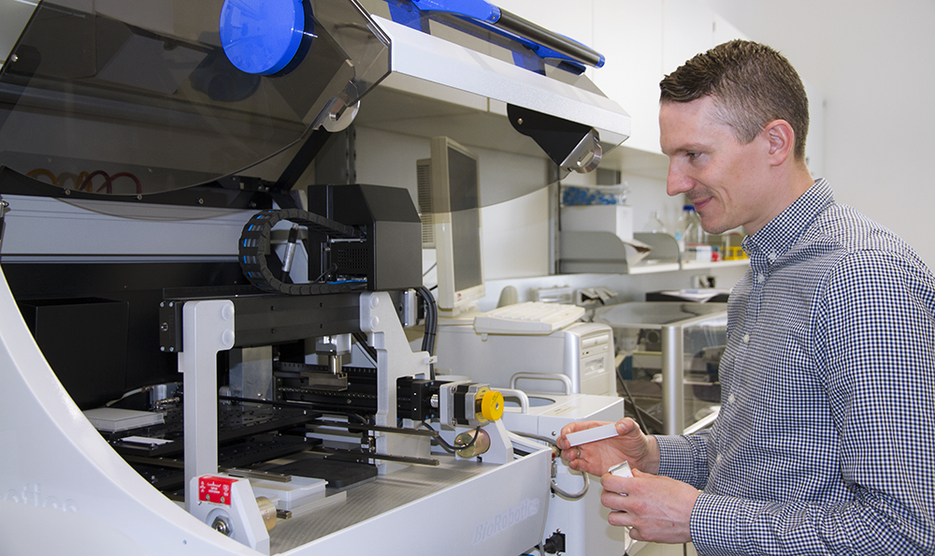New research group at the Rudolf Virchow Center
04/04/2018Since January Dr. Hans Michael Maric is a new group leader at the Rudolf Virchow Center of the University of Würzburg. His research focuses on the development of new drugs based on microarrays.
Proteins are essential components of all known organisms. They are involved in practically every process of life. One of the major challenges life science is facing is to identify and characterize functionally relevant proteins and to apply this knowledge therapeutically.
Career
Hans Maric studied chemistry in Würzburg before he gained his doctoral degree in structural biology in the lab of Professor Schindelin. The Lundbeck Foundation then allowed him in the group of Professor Strømgaard in Copenhagen to pursue a new principle of influencing the brain activity by pharmaceutically active peptides. In order to test his patented, peptidic substances more comprehensively, he then conducted his research as a visiting scientist at the University Hospital Hamburg-Eppendorf in the research group of Professor Kneussel in the Institute of Molecular Neurogenetics. Fascinated by the microarray technology, Maric accepted the call for assistant professor at the newly founded Center for Biopharmaceuticals in Copenhagen in 2015. With the help of the Hoerslev, the Brødrene Hartmanns and the Frimodts Foundation he succeeded to build a unique microarray platform.
Enabling the design of new drugs
He now wants to use his microarrays at the Rudolf Virchow Center. Among other things, he wants to develop a fundamentally new class of biomolecules, so-called "Protein Superbinder". "At first, I worked with simple fragments of a protein binding partner, which I then further improved in an iterative process. Now I am also working with starting molecules which were predicted in silico", explains Maric. "Protein Superbinder" bind highly specific and highly affine to the desired target protein, which enables testing of new therapeutic principles and stimulates the development of new drugs. Due to their comparatively small size and superior binding properties, these molecules are also ideal as protein markers. "New high-resolution microscopy methods have a resolution down to the nanometer range and therefore benefit enormously from labeling methods that bring the fluorophore close to the target protein by a few nanometers, unlike conventional antibodies" says Maric.
His methodological focus is on organic synthesis and protein chemistry as well as on biophysical protein and protein interaction analysis methods. In addition, Maric brings a new expertise to Würzburg: the quantification of protein-protein interactions in high-throughput and the production of selected peptide drug candidates on a gram scale.
The founding of his research group is supported by the program "Excellent Ideas" of the University of Würzburg and the Junior Research Group Leader Program of the RVZ. The Research Group Maric is therefor part of the Department of Biomedicine and the Department of Biotechnology and Biophysics of the Biocenter.
More information about the Rudolf Virchow Center and the research group from Dr. Hans Maric is available at this website: http://www.rudolf-virchow-zentrum.de/en/research/research-groups/maric-group/research.html
Contact
Dr. Hans Michael Maric (Rudolf Virchow Center of the University of Würzburg)
Tel. 0931 31 85371, Hans.Maric@virchow.uni-wuerzburg.de
Dr. Daniela Diefenbacher (Press Office, Rudolf Virchow Center of the University of Würzburg)
Tel. 0931 31 88631, daniela.diefenbacher@uni-wuerzburg.de



![[Translate to Englisch:] Dr. Hans Michael Maric (Foto: Daniela Diefenbacher, RVZ) Foto von Dr. Hans Michael Maric im Labor](/fileadmin/_processed_/a/3/csm_Hans_Maric_RVZ_Laborfoto_d048d922e6.png)
